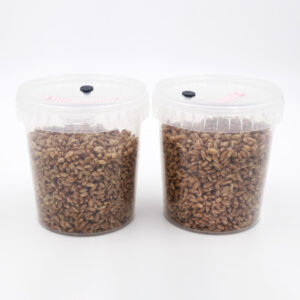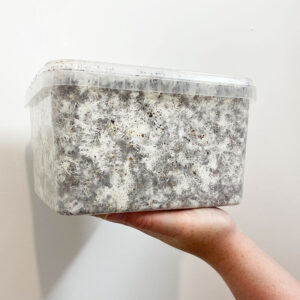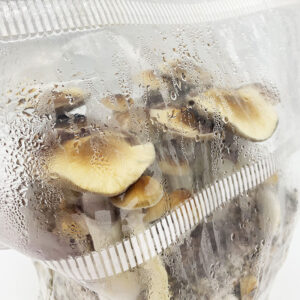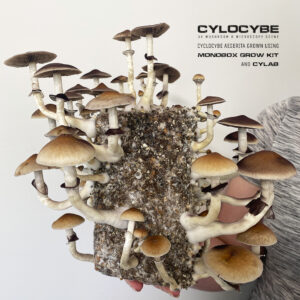Grow Guide for XXL Enhanced MonoBox™ Grow Kit
Step 1: Inoculation of Sterile Grain Spawn
Reducing the risk of contamination is crucial in successful mushroom cultivation, and you can achieve this by working in a small, clean, and draft-free space, ideally using a Still-Air Box (SAB).

Before starting, cleanliness is paramount; take a shower, put on fresh clothes, and cleanse your hands and forearms with a blue Clinell wipe. Ensure you have a face mask on, but hold off on your sterile gloves until step 4.
Next, prepare your syringe by attaching a new sterile needle. Now, take your SpawnTubs from their boxes. Be mindful, once removed from the boxes, they are more exposed to the open air and any potential contaminants – that’s why working within a SAB is strongly recommended to minimize this risk.
You’ll notice a grey rubber injection port on the lid of each SpawnTub. Use a green Clinell alcohol wipe to sanitize this. Now you’re ready to inject the spore or culture solution. Pierce the needle through the cleaned rubber port and inject 1.5-2ml of solution into the port. Just remember, the filters on the lid are not for injection! Now give the SpawnTubs a nice shake to distribute the solution all around (this will dramatically increase colonisation time).
Step 2: Colonisation of Sterile Grain Spawn
After injecting the spore solution into the SpawnTubs, it’s time to set the stage for the colonisation process. Remember, Mycelium is alive and needs to breathe, so storing your SpawnTubs in an airtight container is a no-go. Instead, utilise the cardboard boxes that they arrived in. It acts as a perfect shelter for your colonising SpawnTubs and helps keep them free from dirt and dust.
Temperature plays a vital role in the colonisation process. High heat (above 26°C) or cold conditions (below 20°C) can invite problems like contamination or sluggish to non-existent growth. The sweet spot lies between 20-26°C, room temps at a minimum and consistency is key. Heat mats are not recommended as they can cause undue condensation, potentially leading to a breeding ground for contaminants in your SpawnTubs.
Maintaining the right temperature can be challenging. If you find yourself in this situation, an incubator might be the solution. It’s a more cost-effective choice compared to running your home’s heating system constantly, and it tends to yield better results.
With conditions optimised at 26°C, you can usually expect your SpawnTubs to be fully colonised in about 2-3 weeks. Still, nature likes to keep us on our toes, and this timeline can fluctuate based on a multitude of factors. Patience will be your ally here.
Step 3: Spawning to Sterile Substrate
Before proceeding, clean your hands and forearms, and put on your gloves. Take a good handful of coir from the bag of Sterile Coir Substrate™ and set it aside for later use.
 We recommend pouring the rest of the coir into a large bowl to make it easier to mix with your spawn. Open your SpawnTubs and tip the colonised grain out into the coir. The grain will be in solid blocks that you need to break up – it can take quite a bit of force to get started, but be careful not to squish any grains.
We recommend pouring the rest of the coir into a large bowl to make it easier to mix with your spawn. Open your SpawnTubs and tip the colonised grain out into the coir. The grain will be in solid blocks that you need to break up – it can take quite a bit of force to get started, but be careful not to squish any grains.
Swiftly and efficiently break up the spawn into individual kernels of grain, as each one is an inoculation point. The better you spread them through the coir substrate, the faster your colonisation will be! Transfer the mix back into your XXL MonoBox™.
Finish with a thin layer of coir on top that you set aside earlier, until you can’t see any exposed grain. This is called a casing layer.
Secure the lid on the MonoBox™ and store it somewhere warm. An ideal colonisation temperature for many popular species of mushroom mycelium is between 24-26°C, but you can always try to mimic the colonisation temperatures from their natural habitat. Getting the temperature as ideal as possible at this point is crucial for success.
In the right conditions, it should take around 10 days to see full colonisation of the substrate. If it’s taking much longer than this, the risk of contamination starts increasing fast.
Only when you’re confident that the substrate is fully colonised with strong, healthy mushroom mycelium are you ready to begin fruiting.
Step 4: The best bit… Fruiting your mushrooms!
Maintaining a slightly cooler temperature of 20-22°C during the fruiting stage is essential for best results with many popular species of mushrooms. Remove the colonised block, known as a ‘cake,’ from the XXL MonoBox™ and place it inside your grow tent as shown. Fold over the top of the tent so that humidity can build up inside.

 Humidity and FAE (fresh air exchange) are extremely important for pinning and healthy mushroom development, as is temperature and light. They all need to work in harmony. Humidity will naturally build up inside the grow tent from water you previously added to the substrate mix, which is still stored in the cake. Unlike some other grow kits, you should not mist this kit (unless it looks dry).
Humidity and FAE (fresh air exchange) are extremely important for pinning and healthy mushroom development, as is temperature and light. They all need to work in harmony. Humidity will naturally build up inside the grow tent from water you previously added to the substrate mix, which is still stored in the cake. Unlike some other grow kits, you should not mist this kit (unless it looks dry).
The only time you’ll open your tent is when you’re ready to harvest your mushrooms. Even peeking for a few seconds is enough to lose humidity and cause growth defects such as aborted pins and caps breaking. We suggest cutting a 1cm slit through both sides of the tent near the top and placing an electric fan somewhere in the room on a low setting. This will create a gentle air current inside the room, which will help increase the FAE inside the grow tent.
Your mushrooms will need light to grow. We recommend indirect sunlight or a 6-7000K LED or fluorescent light a few feet away – if the light is heating the substrate, move it further away. If you notice the inside of your grow tent looking dry, it may be due to the fan being too close, the holes you cut being too big, or grow lights (if using them) being too close and hot. Observe what’s happening and adjust your setup as required. Fantastic results depend on it.
After around 3-7 days, you’ll hopefully begin to see lots of tiny white dots. These are hyphal knots that will develop into primordia, aka mushroom pins. It will take 4-5 days for them to grow into fully mature mushrooms ready for harvest. During this time, they’ll let you know if something isn’t quite right. Fuzzy mycelium at the base of the mushrooms and/or thin stems are an indication that more FAE is needed. Increasing the fan speed or length of the cuts on the bag might be something to try.
Don’t worry about any mushrooms growing around the sides and bottom of the cake. You’ll still be able to harvest them. If you want to give your mushrooms more room to grow next time, use a fruiting chamber instead of a grow tent. Check out the photos on our CyLab product page for results when growing inside our CyLab fruiting chamber.
When the veil beneath one of your mushroom caps is about to tear off, this is when you should harvest your first flush. If you don’t get there quickly enough, spores will begin to drop from your mushroom caps and make a mess! It’s best to cut the mushrooms off with a clean scalpel or knife. You can also just pull them off, but be careful not to damage the substrate too much.
After you’ve harvested all the mushrooms from your first flush, you can use a method called “dunking” to get more moisture into your substrate. Simply fill a container with water deep enough to submerge your cake and place it in the water. It will float to the top, so you need to use something to weigh it down. You need it to be fully submerged in water at all times.
Place a lid on the container or cover it to keep everything clean. Leave your cake submerged for anything between 6-24 hours, depending on how much patience you have. But obviously, the longer you leave it, the better your results will be. When you remove the cake from the water, give it a rinse under the tap and allow excess water to drain away before placing back into your grow tent.
You should continue to dunk your substrate after each flush. If you’ve taken good care of it, you should achieve multiple flushes of mushrooms from your grow kit before the nutrients are all used up.
We also recommend reading our troubleshooting guide as it’s full of useful information which will help you solve and avoid problems.